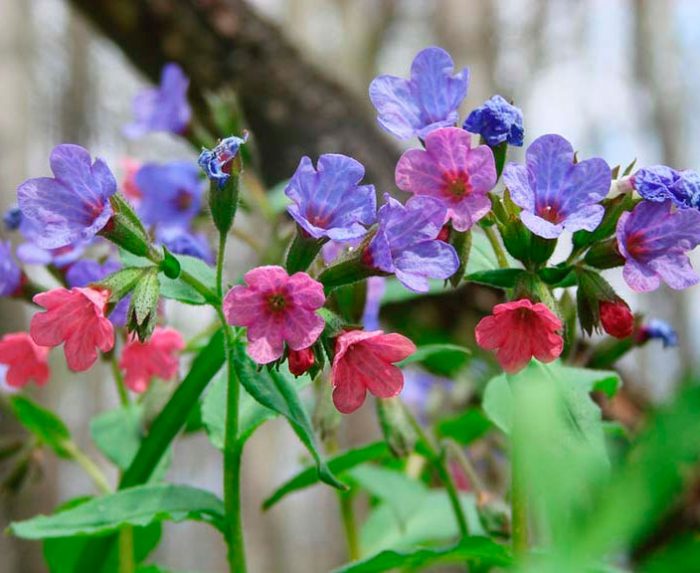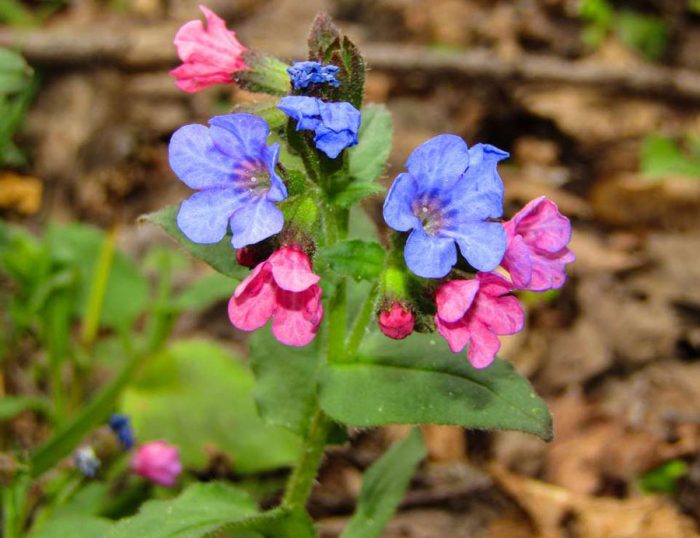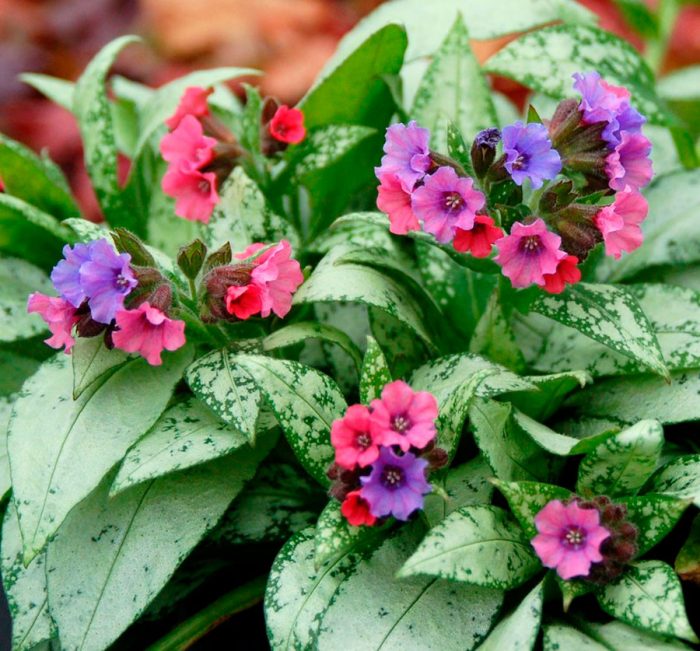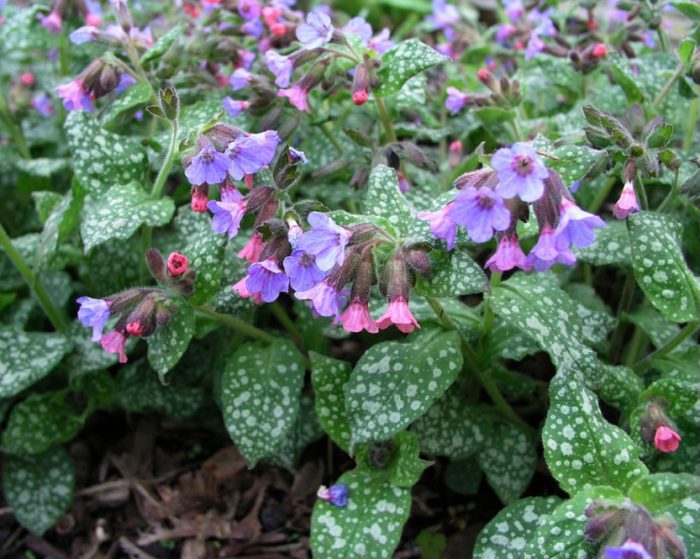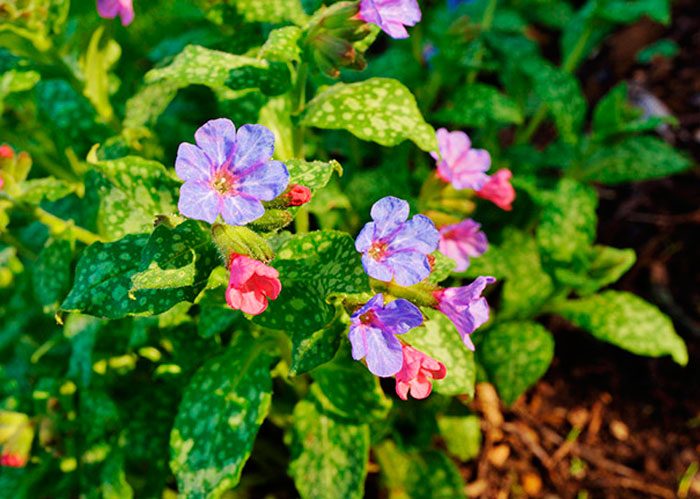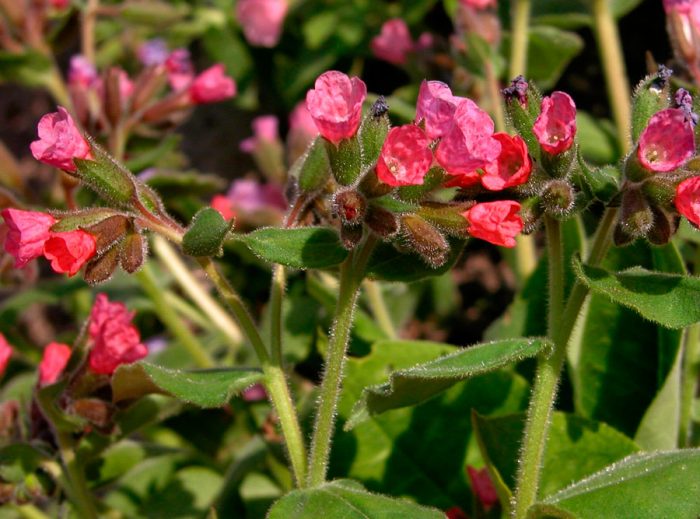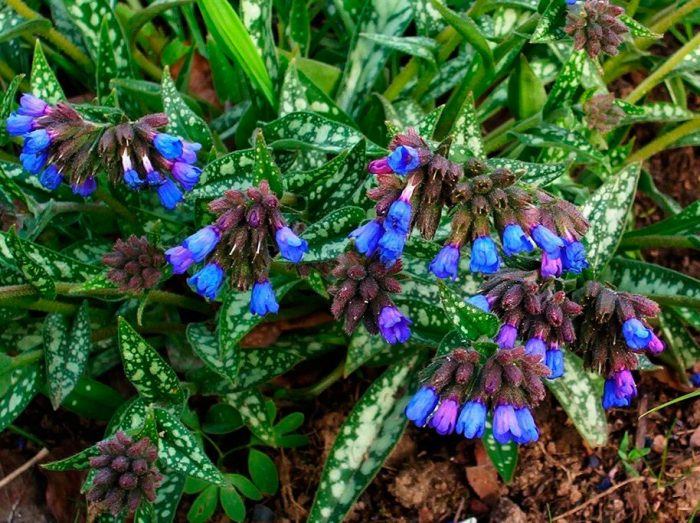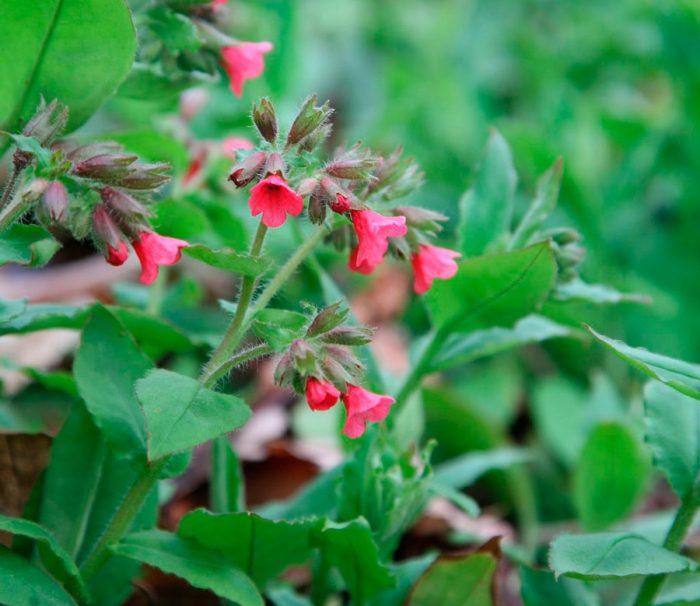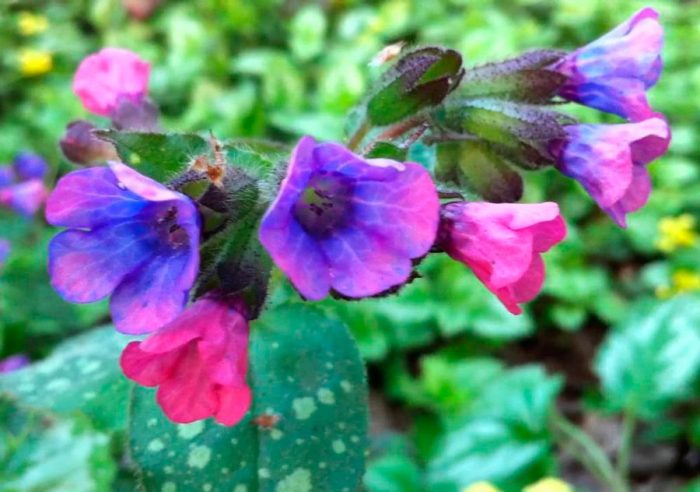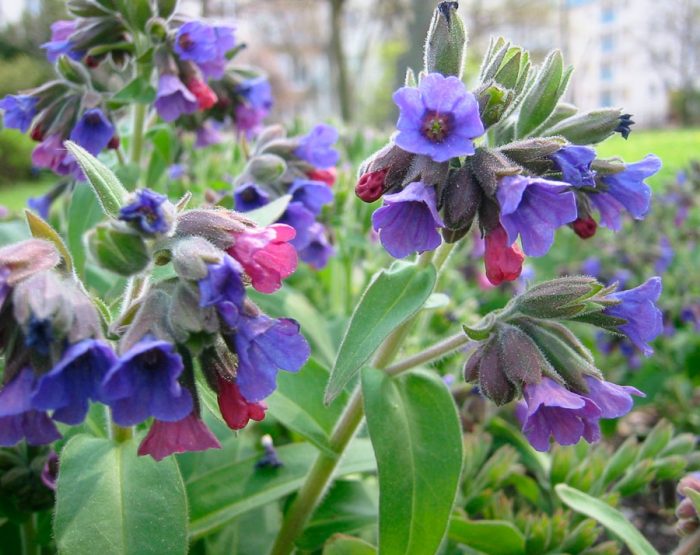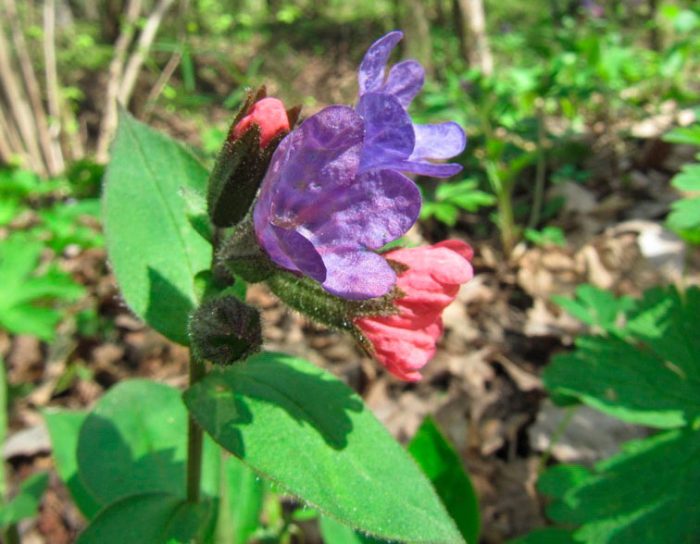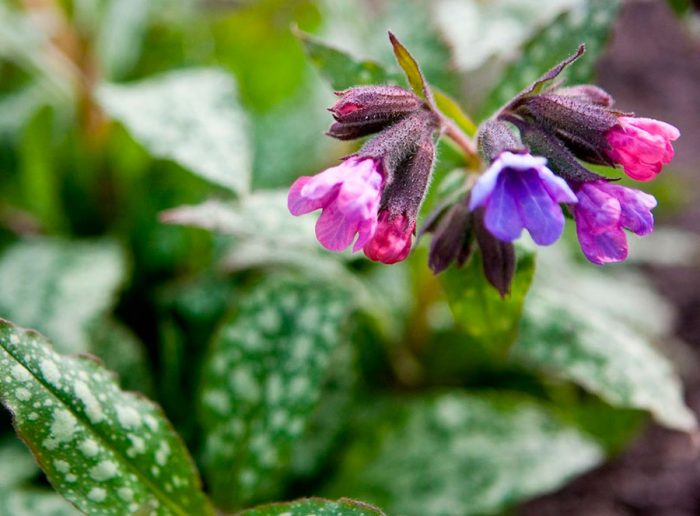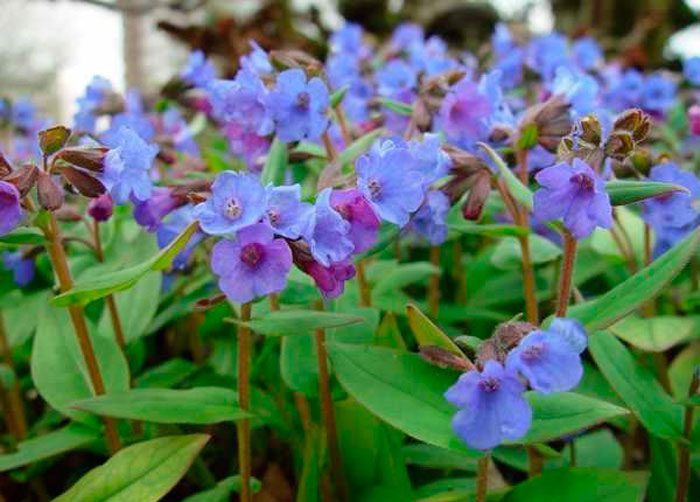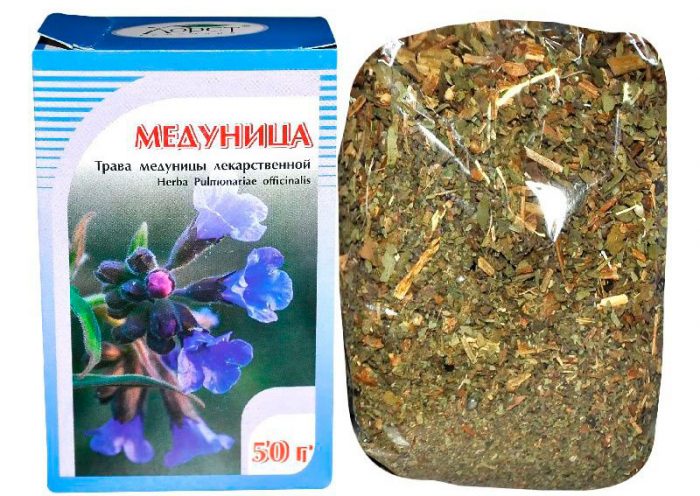The low herbaceous perennial plant lungwort (Pulmonaria) is a member of the Borage family. This genus unites about 15 species that can be found in natural conditions in the mixed and deciduous forests of Eurasia. The Latin name for lungwort was formed from the word "pulmo", which translates as "lung", this is due to the fact that for a very long time the leaves of such a plant have been used during the treatment of lung diseases. And the Russian name is due to the fact that this plant is an excellent honey plant. The lungwort is also often called the pulmonary herb, or the honeycomb, or the lungwort, or the honeywort. Lungwort medicinal in Europe began to be grown in the 16th century, and narrow-leaved lungwort, which is an ornamental plant, entered the culture only in the 19th century.
Content
- 1 Features of lungwort
- 2 Planting lungwort in open ground
- 3 Care of lungwort in the garden
- 4 Types and varieties of lungwort with photos and names
- 4.1 Lungwort (Pulmonaria vallarsae)
- 4.2 Long-leaved lungwort (Pulmonaria longifolia)
- 4.3 Red lungwort (Pulmonaria rubra)
- 4.4 Lungwort (Pulmonaria officinalis)
- 4.5 The soft lungwort (Pulmonaria mollis), or the softest lungwort (Pulmonaria mollissima = Pulmonaria montana)
- 4.6 Unclear lungwort (Pulmonaria obscura), or dark lungwort
- 4.7 Sugar lamb (Pulmonaria saccharata), or spotted lungwort
- 4.8 Narrow-leaved lungwort (Pulmonaria angustifolia)
- 5 Properties of lungwort: benefits and harms
Features of the lungwort
The lungwort is a herbaceous perennial plant, the height of which can vary from 0.08 to 0.5 m. The branchy rhizome is located horizontally. Fleshy roots, which have a cord-like shape, are extremely easy to injure, since they are very fragile, and it takes a long time to fully recover. Basal rosette consists of many large leaf plates with long petioles. Solid leaf plates have a sharpness in the upper part, their shape depends on the species and varies from broad-lanceolate to linear-lanceolate. Stem leaf plates are very few in comparison with basal ones, they are sessile and are small in size. On the surface of erect leafy peduncles, as a rule, there is pubescence, their formation occurs before the growth of basal leaf plates begins. The lungwort, whose flowers are pink, blue, white, lilac or blue, have a double perianth, a five-toothed bell-shaped calyx, and a five-lobed funnel-shaped corolla with a tube and an open throat, 5 hair bundles protrude from it.The flowers are part of the curl inflorescences, which are apical. Such a culture has one distinctive feature, for example, flowers and buds on the same bush have different colors, for example, when a pink bud opens, a lilac, white, blue or blue flower appears. Flowers of different colors can often grow on one bush. Experts attribute this phenomenon to the fact that the level of acidity of the cell sap in the corollas is gradually changing: in a pink corolla, the juice has an acidic reaction, and in blue or blue it is alkaline. Pollination of lungwort requires insects with long proboscis, for example, bumblebees. The fruit is a nutlet that, after ripening, divides into 4 one-seeded lobes with fleshy seedlings that attract ants.
Planting lungwort in open ground
For growing lungwort, an area located in the shade or partial shade is perfect. The soil should be rich in humus, loose, slightly acidic, alkaline or neutral. Loamy or sandy loam soil is best suited. If this plant is planted in an open, well-lit area, then its flowers will have a paler color. The fact is that lungwort reacts extremely negatively to high air temperatures and to the scorching rays of the sun.
Before proceeding with sowing lungwort, the site must be prepared. To do this, he will need to dig to the depth of a shovel bayonet with the simultaneous introduction of organic matter (humus or compost) into the soil. In this case, do not forget to remove all weeds from the site. Sowing seeds in open soil is carried out in spring, while the soil is saturated with melt water. Also, in a specialized store, if you wish, you can buy saplings of lungwort, which are planted in open ground in the same way in the spring after the return spring frosts are left behind, and the top layer of the soil warms up well. Before buying seedlings, they need to be thoroughly examined, and all those plants that are injured, with signs of diseases or the presence of harmful insects, as well as those that show that they were poorly or incorrectly looked after, must be discarded.
On a site that was prepared in advance, it is necessary to make planting holes, the distance between which should be at least 0.2–0.3 m, and their size should be such that the root system of the bushes together with a lump of earth could fit in them. If a site is selected for planting, where water stagnation is observed during rains, a drainage layer should be made at the bottom of each hole; for this you can use small pebbles, coarse sand or crushed stone. The plant is pulled out of the container along with an earthen lump and placed in a hole, which is then covered with soil, then the surface of the earth around the bushes is well compacted. Planted lungwort needs moderate watering.
Care of lungwort in the garden
If a site located in partial shade or shade was chosen for planting lungwort, then caring for it is greatly simplified.
Watering
Watering should be systematic, while making sure that the soil on the site is slightly damp all the time. But at the same time, remember that in no case should the liquid stagnate in the root system of plants. Particular attention should be paid to watering during bud formation and flowering. If the site is shaded or in the shade, then the bushes will need to be watered much less often compared to flowers growing in a sunny place. If lungwort grows in a well-lit area, then it is recommended to cover its surface with a five-centimeter layer of mulch, in which case moisture from the soil will evaporate much more slowly. The mulching layer is also good in that it can significantly reduce the number of weeding. As they grow older, the bushes need less watering.
Fertilizer
It is necessary to feed such flowers 1 time per season, in spring, at the very beginning of the active growth of young leaf plates. To do this, use a solution of complete mineral fertilizer (for 1 bucket of water from 15 to 20 grams).
Preparing for winter
When the bushes have faded, the peduncles must be carefully removed from them. If desired, with a pruner or a sharp knife, you can also cut off old sheet plates that have become unsightly. In late autumn, the area with these flowers should be covered with a layer of mulch (peat). Some species (for example, lumpy lungwort and soft lungwort) are quite thermophilic, so they need a more reliable shelter, for this a thick layer of sawdust, dried foliage or needles is poured over the mulch.
Pests and diseases of lungwort
Such a culture is highly resistant to all diseases, as well as to most of the harmful insects. But if she is not provided with proper care or does not adhere to the rules of agricultural technology of such a plant, then problems may arise with it. For example, if the bushes are watered abundantly, or prolonged rains begin, and even with sudden changes in temperature, the flowers can be affected by powdery mildew or root rot. Diseased bushes should be dug up and destroyed as soon as possible, while the remaining healthy flowers, for prevention purposes, should be sprayed with a fungicidal preparation containing copper against root rot, and with a preparation containing sulfur for powdery mildew.
From insects, snails and slugs can harm such a plant. As a rule, they appear on the site when there is high humidity. If there are a lot of gastropods, then in order to get rid of them, the site must be treated with Thunder, and the instructions attached to it must be followed. However, if there is such an opportunity, then collect such pests manually or make a special trap, for this you need to dig several glass cans flush with the surface of the site into the soil, into which a small amount of fermented compote or dark beer is poured. The mollusks will surely crawl down to the smell of the bait and be trapped.
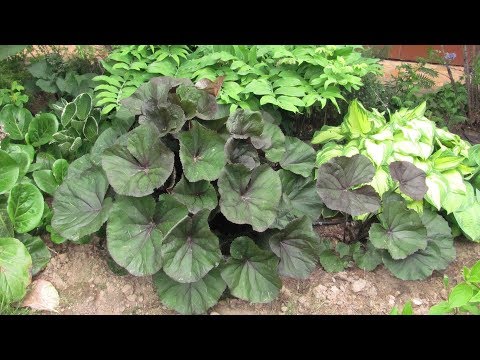

Watch this video on YouTube
Types and varieties of lungwort with photos and names
The types and varieties that are most popular with gardeners will be described below.
Lungwort (Pulmonaria vallarsae)
This species is considered very rare, in nature it is found only in the Apennines at an altitude of up to 1.5 thousand meters above sea level. On the surface of lanceolate leaf plates, there is pubescence and a very large number of silver specks. The foliage is about 10 centimeters wide and up to 20 centimeters long. The height of the peduncles is about 0.45 m, they form red-purple flowers. This species has been used by breeders to obtain varieties with silvery leaf plates. The most popular cultivar of such a lungwort is the Margery Fish: the front surface of the leaf plates of such a frost-resistant plant is silvery, and the back is green.
Long-leaved lungwort (Pulmonaria longifolia)
This type is widespread in western or northern Europe. The height of the bush is about 25 centimeters, the width of the spectacular leaf plates is about 6 centimeters, and their length can be up to 50 centimeters, their shape is lanceolate-arrow-shaped or lanceolate. The front surface of the foliage has pubescence, it is dark green with specks of silver color, and the lower surface is greenish-gray and denser. Peduncles reach a height of about 25 centimeters, pink flowers are formed on them, which after a while turn blue. The following garden forms are most popular with gardeners:
- Bertram Anderson... The color of the flowers is deep blue, and the leaf plates are dark green, their surface is decorated with irregular specks of whitish-silver color.
- Lewis Palmer... The length of the dark green leaf plates is about 0.3 m, there are whitish-green spots on their surface. The flowers are initially pink, but after a while their color changes to blue.
- Majesty... The color of the flowers is pinkish blue. The length of the grayish-silvery leaf plates is about 0.3 m, along the edge there is a narrow green edging.
- Cevennensis... This subspecies has large blue flowers. The length of the narrow leaf plates is about 0.65 m, and on their surface there are dots and specks of silver color.
Red lungwort (Pulmonaria rubra)
This species is represented by a long-rhizome plant that can be found in nature in the subalpine beech and pine forests of the mountains of Bulgaria, Hungary and Albania. The flowering of this species is long and lush, and its flowers are painted in a deep red color. Monochromatic greenish leaf plates are narrow and glossy. This type is cultivated by gardeners as a ground cover plant that needs shelter for the winter. The most popular varieties are:
- David Ward... The color of the flowers is coral red. Greenish-blue leaf plates are large and wide, they have a well-distinguishable white edging along the edge.
- Barfield Pink... The leaf plates are green, and the flowers are pink, while on their surface there are narrow stripes of white.
- Redstart... This variety is distinguished by its early flowering. The leaf plates are green and the flowers are coral red.
Lungwort (Pulmonaria officinalis)
In the deciduous forests of Eurasia, this species is very widespread. The height of the bushes is about 0.3 m. The rhizome is black and branched, the shoots are weak, and on their surface in the upper part there are glands and bristles. On the surface of alternating green leaf plates, there are specks of a whitish color. Basal leaves have an ovoid-heart-shaped shape and long petioles, while the stem leaves are not so wide and reach about 16 centimeters in length. Loose paired curls consist of red flowers, reaching about 15 mm in diameter, after some time they change their color to purple. The most popular varieties are:
- Alba... The perianth is white.
- Imnaculata... This variety has solid green leaf plates.
- White Wings... White flowers have pink eyes. There are white specks on the surface of the green leaf plates.
- Sissinghurst White... The length of the leaf plates is about 0.25 m, there are many white spots on their surface. The buds are pale pink and the flowers are snow white.
- Coral... The color of the flowers is pinkish. There are white specks on the surface of green leaf plates.
- Cambridge Blue... The foliage is heart-shaped, and has a large number of white spots on its surface. Many bluish-pink flowers form on the bush.
The soft lungwort (Pulmonaria mollis), or the softest lungwort (Pulmonaria mollissima = Pulmonaria montana)
This spectacular short-rhizome plant is found naturally in the forests of Dzungaria, Europe, Altai and the Caucasus. The height of the bushes is about 0.55 m and they are slow growing. The length of the rosette leaf plates is about half a meter, they have a greenish-silver color, and there is pubescence on their surface. Peduncles grow from the outlet, on which a large number of lilac-blue flowers are formed. The bush also looks attractive due to the fact that it has a strict and dense shape.
Unclear lungwort (Pulmonaria obscura), or dark lungwort
In nature, this species can be found in mixed and deciduous forests in Europe. The height of the bush is about 0.3 m. The pointed basal leaf plates have an ovoid-heart-shaped shape and a solid green color, on their surface there is a hard bristle. They also have long petioles with narrow wings.In flowers, the color of the corollas is pink, but after some time it changes to blue or violet-blue. This species also has a white-flowered form.
Sugar lamb (Pulmonaria saccharata), or spotted lungwort
This species comes from the Apennine shrubs from the southeastern part of France and from the northern part of Italy. Such a plant from its stems forms flooring, the height of which can vary from 0.15 to 0.3 m. Matte evergreen leaf plates are oval in shape, their width is about 10 centimeters, and their length is about 27 centimeters, there are silvery specks on their surface. Inflorescences consist of flowers of a carmine color, which after a while is replaced by purple. Thanks to this species, a large number of hybrids and varieties were born, which are popular with gardeners:
- Mrs Moon... The color of the buds is pink, and the flowers are purple-blue. On the surface of the foliage there are specks of white and silver.
- Pink Don... The leaf plates are decorated with white spots. The flowers are pink at the beginning, but over time they turn purple.
- Dora Bickveld... The color of the leaf blades is greenish, and the flowers are pale pink.
- Leopard... There are a lot of spots on the surface of the dark green foliage of such a hybrid. The color of the flowers is pinkish red.
- Smoky Blue... The flowers are colored blue, and there are silvery spots on the surface of the foliage.
Narrow-leaved lungwort (Pulmonaria angustifolia)
This species is found naturally in Asia Minor and Europe, while it prefers to grow on river banks, as well as in deciduous forests. The height of such a perennial plant is about 0.3 m. On the surface of the powerful stems there is a dense bristle and a small number of glands. The shape of the leaf plates is linear-lanceolate, and their length is about 0.3 m, on their both surfaces there is a coating consisting of bristles. Paired curls consist of flowers of a carmine-red hue, which after some time change their color to blue. The most popular are the following varieties:
- Mousans Blue... The length of the dark green leaf plates is about 0.3 m, the flowers are dark blue in color.
- Manstad Blue... A vigorous bush is decorated with blue flowers and green monochromatic foliage.
- Saman Glow... The flowers are painted in a salmon pink color, while the foliage is green.
- Bats Pink... The flowers are coral pink. The length of the dark green foliage is about 0.25 m, there are white spots on its surface.
Properties of lungwort: benefit and harm
Medicinal properties of lungwort
Lungwort has a unique composition that includes tannins, mucus, tannins, saponins, iron, alkaloids, anthocyanins, flavonoids, silicic and ascorbic acids, carotene, rutin and other useful substances necessary for the human body. Saponins and tannins have a powerful softening and expectorant effect, due to which the patient feels a significant improvement in well-being in any respiratory tract disease. Such a plant is also distinguished by its antibacterial, astringent, hemostatic, anti-inflammatory, diuretic, antiseptic and enveloping effect. It can also strengthen the immune system. Means made on the basis of lungwort are recommended for gynecological problems, cancer, hemorrhoids, skin diseases, bleeding, diseases of the respiratory system, stomach and intestines, for the prevention of heart attacks and strokes. But in order for such treatment to be effective, it is necessary to use these drugs correctly, and for this it is necessary to consult with a qualified specialist.
The fresh juice of such a flower can be used externally for wounds and cuts, as it has an astringent, hemostatic and antimicrobial effect. If the wound is large enough, a gruel consisting of crushed shoots and plant foliage should be applied to its surface.The juice is also used to treat cracked heels and calluses.
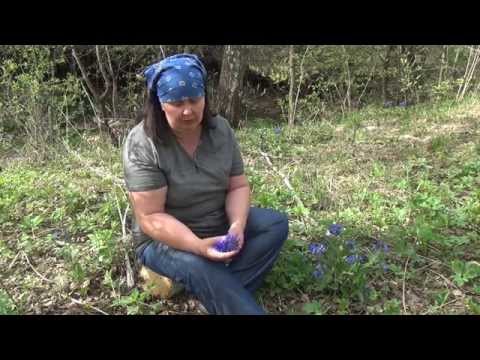

Watch this video on YouTube
Contraindications
There are no special contraindications to the use of funds made on the basis of lungwort, but they must be taken with caution, as they can contribute to the appearance of severe nausea. Those people who have an individual intolerance to this plant cannot use it for treatment.

